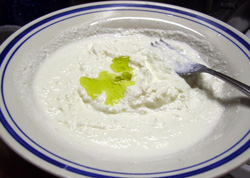 It is one of life’s little truths that the simplest dishes are usually the most satisfying. While I often dream about elaborate feasts consisting of all sorts of exotic dishes and breathtaking desserts, the recipes that I come back to again and again are the ones that were introduced to me as a child.
It is one of life’s little truths that the simplest dishes are usually the most satisfying. While I often dream about elaborate feasts consisting of all sorts of exotic dishes and breathtaking desserts, the recipes that I come back to again and again are the ones that were introduced to me as a child.
A paper-thin slice of veal flash-fried in a bit of olive oil with garlic and oregano. Creamy arborio rice served with a pat of butter and a handful of freshly-grated parmiggiano. Apple or peach slices dipped quickly in homemade wine and then gobbled up.
Simple yet completely satisfying, these are the dishes that guided me through childhood, and guide me still. I’m not sure what it is about these dishes that makes them so important to me. Maybe it’s that these dishes remind me of home. And maybe it’s that they are the dishes that I associate with the people that have had the greatest impact on my life: my parents and grandparents. Somehow, I am comforted knowing that these are the foods that they ate as children.
Yet of all the dishes that have a special place at my table, none is more special than pasta e ricotta (pasta with ricotta).
This pasta dish consists of four ingredients: ricotta, water, olive oil and pasta. It is done in the time that it takes you to boil a pot of water and cook your preferred pasta. In our family, we prefer penne for this recipe. Penne are a tubular pasta that are usually cut on the diagonal. They tend to come in two textures: penne lisce (smooth penne) or penne rigate (ridged penne). This type of pasta is perfect for a creamy sauce, like ricotta, because the sauce becomes trapped within the pasta tubes. As well, using the ridged penne allows the sauce to cling to the surface of the pasta. This results in a burst of sauce with every bite.
The ricotta (ricotta means twice cooked) is also an interesting ingredient. Ricotta cheese is usually made from the whey that drains off during the making of either provolone or mozzarella. Ricotta is characterized by being somewhat firm and very fresh-tasting. It is an excellent cheese for fillings and dips, and also eaten on its own. We would often have ricotta and honey as an after-school snack.
 In this particular recipe, three-quarters of a cup of ricotta is put into each individual pasta dish. About a minute before you are ready to remove the pasta from the boiling water, a few spoonfuls of the pasta water are added to the ricotta and then mixed in. The hot water serves to loosen the ricotta and the starch in the water, which comes from the cooking pasta, helps to naturally thicken the ricotta sauce. A few drops of olive oil are added to the sauce for flavour. Once the pasta is cooked, it’s added directly to each pasta dish. Mix well and serve.
In this particular recipe, three-quarters of a cup of ricotta is put into each individual pasta dish. About a minute before you are ready to remove the pasta from the boiling water, a few spoonfuls of the pasta water are added to the ricotta and then mixed in. The hot water serves to loosen the ricotta and the starch in the water, which comes from the cooking pasta, helps to naturally thicken the ricotta sauce. A few drops of olive oil are added to the sauce for flavour. Once the pasta is cooked, it’s added directly to each pasta dish. Mix well and serve.
Over the years, I have seen many variations of this recipe. People will often add the first fresh peas or fava beans of the season. I’ve also seen variations where milk is added to loosen the ricotta and the sauce is then flavoured with a sharp cheese such as Pecorino Romano.
Regardless of how you choose to flavour the sauce, this dish is the epitome of home cooking. So simple. So comforting. So beautiful.
Ciao!
Pasta e Ricotta (Pasta with Ricotta)
Penne rigate (or whichever pasta you prefer)
3/4 cup of ricotta (per serving)
2-3 tablespoons of pasta water (per serving)
1 tablespoon olive oil (per serving)
Bring a large pot of water to boil and add salt.
Add the penne rigate and cook according to package directions.
About a minute before the pasta is ready, put a 3/4 cup of ricotta into each serving plate.
Add 2 to 3 tablespoons of the pasta water and mix well. The ricotta should loosen and become creamier.
Add 1 tablespoon of olive oil to each serving dish and mix well. As soon as the pasta is ready, drain and portion out the pasta directly into each serving dish.
Mix well so that the pasta is completely covered in the ricotta sauce.
Serve and enjoy!
-- Originally published on Ivonne Mellozzi's blog Cream Puffs in Venice.
